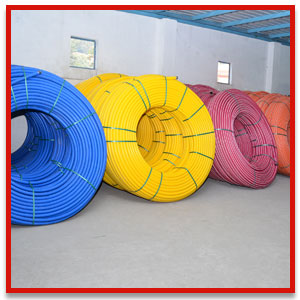Features
Features
LONG LIFE
As against only a few years life of conventional pipes such as C.I., PVC, GI, Steel, Cement, etc,. the calculated life of HDPE pipes & ducts is 50 years at normal working temperature and pressure.

TOUGH & STRONG
The pipes bear high impact resistance and are thus strong and resilient to withstand static and dynamic loads due to internal (fluid) as well as external (soil) pressures. Rough handling, traffic loads and even freezing conditions do not cause the pipe to break or crack.
LIGHT WEIGHT
As HDPE pipes & ducts are many times lighter than conventional pipes, transportation and installation is easy and very cost effective.
SMOOTH INNER SURFACE
In addition to the smooth external surface, the pipes & ducts have an extremely smooth inner surface too, thus offering very low frictional resistance to fluid flow. Further, the non adhering characteristics of HDPE allow even solid particles to be carried along the fluids inside the pipes.
FLEXIBLE
HDPE pipes & ducts are extremely flexible and bend without cracking. This property enables long lengths of the small diameter pipe to be transported as coils thus saving on joints.
.jpg)
INERT TO CHEMICALS
The pipes possess excellent resistance to chemicals making them suitable for handling most of the corrosive acids and also alkalies. The pipes are completely neutral to chemicals and hence widely useful in chemical plants.
NON-HAZARDOUS
Due to its property of being non toxic and inert, HDPE is non hazardous. This enables HDPE pipes to be used for conveyance of potable water.
CORROSION RESISTANT
Resistance to electrolytic as well as galvanic corrosion make HDPE pipes & ducts best suited for underground installations.
LOWER THERMAL CONDUCTIVITY
The fluid transportation in HDPE PIPES remains at a more uniform temperature than in other types of pipes. This is due to the lower thermal conductivity of HDPE as a result of which the transfer of heat on the outer surface from the atmosphere is much slower. Further, due to the superior elongation property of HDPE PIPES., they can be used in very cold climatic conditions too, where there is any likelihood of the fluids freezing within the pipe. As the temperature goes down to subzero, the pipe simply expands to accommodate the volumetric expansion of the fluid. This excellent property is unlike in most other conventional pipes which would crack due to their rigidity.
HIGH ELECTRICAL RESISTANCE
As the dielectric strength of HDPE is very high, the pipes are extensively used as electrical conduits. No stray electrical currents can be transmitted from outside.
